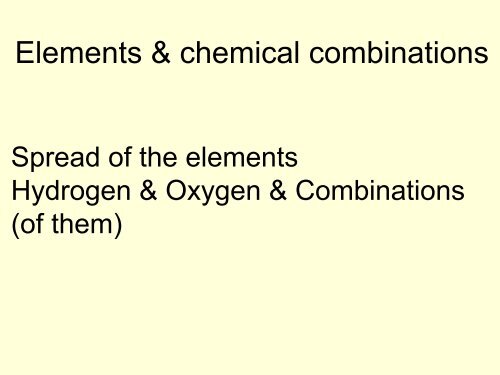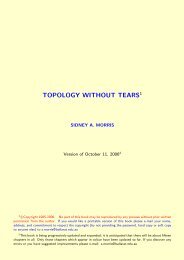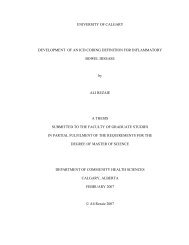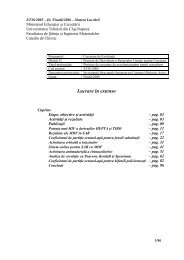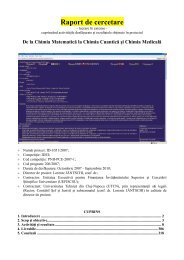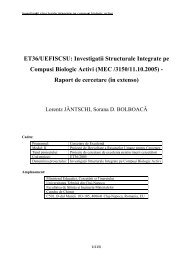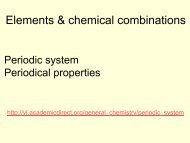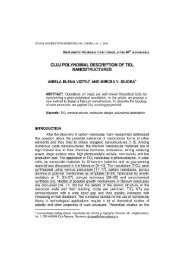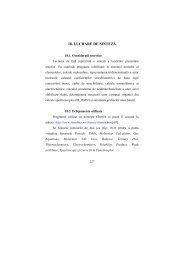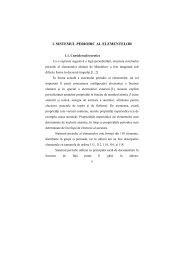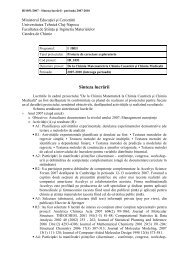Elemente si combinatii chimice
Elemente si combinatii chimice
Elemente si combinatii chimice
You also want an ePaper? Increase the reach of your titles
YUMPU automatically turns print PDFs into web optimized ePapers that Google loves.
Elements & chemical combinations<br />
Spread of the elements<br />
Hydrogen & Oxygen & Combinations<br />
(of them)
•<br />
Spread of the elements in the<br />
atmosphere<br />
Gas shell surrounding the Earth is the<br />
atmosphere. Atmosphere is formed mostly<br />
from nitrogen (78%) and oxygen (21%),<br />
along with other elements in small<br />
quantities.
•<br />
•<br />
Spread of the elements in the crust<br />
Clarck: Percent of the<br />
element in the Earth crust<br />
is named clarck, after the<br />
name of the American<br />
geochemist F. W.<br />
Clarcke.<br />
The science having the<br />
subject of research the<br />
spread of the elements in<br />
the crust, with forming<br />
and compo<strong>si</strong>tion of the<br />
minerals is named<br />
geochemistry.
Spread of the elements in crust<br />
Element O Si Al Fe Ca Na K Mg<br />
% 46.5927.728.135.01 3.632.852.602.09<br />
Element Ti H P Mn S Cl Cr Ni Co<br />
% 0.63 0.130.130.100.0520.0480.0370.0200.001<br />
In crust 15 elements, majority from the beginning of the<br />
periodic system, with low Z, are about 99.8%. Most spread<br />
elements in the crust: oxygen, <strong>si</strong>licon and aluminum, with<br />
over 82%.
Mineral class Examples<br />
Minerals<br />
Native Diamond, coal, S, Au, Ag, Cu, Pt, Pd<br />
Halogenated NaCl (also known as salt, common salt, table salt<br />
or halite), KCl, CaF 2 , KCl·MgCl 2 ·6H 2 O<br />
Oxides and<br />
hydroxides<br />
Sulfides,<br />
arsenides<br />
Al2 O3 , AlO(OH), Al(OH) 3 , Fe2 O3 , FeO, Fe3 O4 ,<br />
MnO2 , TiO2 , SnO2 , SiO2 , UO2 , U3 O8 FeS2 , PbS, ZnS, HgS, CuS, Sb2 S3 , Bi2 S3 , MoS2 ,<br />
CuFeS2 , NiAs, CoAsS<br />
Carbonated CaCO 3 , MgCO 3 , CaCO 3 ·MgCO 3 , FeCO 3 ,<br />
MnCO 3 , Cu 2 (CO 3 )(OH) 2 , Cu 3 (CO 3 ) 2 (OH) 2<br />
Nitrates NaNO 3 , KNO 3
Hydrogen
•<br />
•<br />
•<br />
•<br />
•<br />
•<br />
1s1 configuration and ionization stability implies that the<br />
hydrogen to form, in most of the cases, covalent bonds.<br />
Ions H + & :H- are unstable – chemical this fact are<br />
expressed with the term ‘very reactive’<br />
Thus, due to the intense electrostatic field surrounding<br />
the proton, the proton it cannot exist alone in same<br />
solution with polar molecules, or species which can be<br />
polarized – it reacts instantly with them.<br />
In water, H+ ion stabilizes becoming hydronium ion -<br />
H3O + , and in ammonia become ammonium ion, NH +<br />
4 ,<br />
the coordinative bond being due to a pair of NH3 unbonded electrons.<br />
Formal: H + + H2O → H3O + , ΔH= -1093 kJ·mol-1 Actually exists more than one hydronium species<br />
containing 3-12 water molecules, most likely being:<br />
(H2O) 4H<br />
+ , but for <strong>si</strong>mplicity all are written as H3O +
•<br />
Hydrogen have three isotopes : protium,<br />
deuterium, and tritium: 1<br />
1 H, 2<br />
1 H (noted D) şi 3<br />
1 H<br />
(noted T). Of course the mass of D is twice of<br />
the mass of protium and the mass of tritium is<br />
three times than of protium. 99.985% from<br />
crust’s hydrogen is protium and only 0.015% is<br />
deuterium. This is the reason for which the<br />
atomic mass of the hydrogen is fractional<br />
(1.008). Heaviest isotope - tritium - is β- radioactive, having the halving time T1/2 = 12.26<br />
years, pas<strong>si</strong>ng to helium. It can be used without<br />
danger as radioactive tracer – shows the<br />
manner in which a succes<strong>si</strong>on of chemical<br />
reactions or technological stages are deployed.
•<br />
•<br />
Obtaining of the hydrogen<br />
From low-mass hydrocarbons. In the industrial<br />
processes of gasoline refining, hydrogen is the<br />
secondary product. Thus, during synthe<strong>si</strong>s of the<br />
octane, C8H18, starting from small molecules,<br />
hydrogen are obtained too:<br />
2C2H6 + C4H8 → C8 + H2 H 18<br />
Other procedure is to crack hydrocarbons<br />
breaking of the larger to smaller hydrocarbons –<br />
it results hydrogen and unsaturated<br />
hydrocarbons. For instance:<br />
C12H26 → C5H10 + C4 H 8<br />
+ C3H6 + H 2<br />
–
• Other methods uses along with hydrocarbons,<br />
water vapors and catalysts. Thus, for methane:<br />
CH4 + H2O → CO + 3H2 • Product (CO + H2 mixture) is known as gas of<br />
synthe<strong>si</strong>s because can be used as raw material<br />
in a series of industrial syntheses, such as of the<br />
methyl alcohol (or methanol). With a second<br />
catalytic reaction the carbon oxide may be<br />
converted with water vapors to carbon dioxide<br />
and hydrogen – phenomena being known as the<br />
reaction of water gas:<br />
CO + H2O Fe/Cu→500°C<br />
CO2 + H2 Fe/Cu - fer activated with copper.
Chemical properties of hydrogen.<br />
Reactions with nonmetals<br />
CH<br />
4<br />
SiH 4<br />
PH 3<br />
C<br />
Si<br />
HF<br />
F<br />
2<br />
H2<br />
Cl2<br />
O2<br />
P4<br />
s8<br />
N<br />
2<br />
NH 3<br />
HCl<br />
H 2S<br />
H 2O
Chemical properties of hydrogen.<br />
Reactions with metals<br />
With other metals does not react, but may associate,<br />
through specific interactions, to give interstitial metallic<br />
hydrides, very <strong>si</strong>milarly to alloys
•<br />
•<br />
•<br />
Reduction character of the hydrogen<br />
With many combinations, organic included, hydrogen<br />
have a reduction character, <strong>si</strong>milarly with the one from<br />
the reaction with nonmetals (oxidants). Due to this<br />
character, hydrogen is industrially used in the reaction<br />
for copper (or other metals) reduction: Cu2+ (aq) + H2(g) =<br />
Cu (s) + 2H + (aq)<br />
Thus, after extracting as cooper sulfate of the cooper<br />
from ore, though bubbling of hydrogen, metalic cooper<br />
may be separated. About 1/3 from all industrial hydrogen<br />
is used for such kind of reductions. The necessary<br />
condition for this reduction is that the redox potential (ε°)<br />
of the metal to be po<strong>si</strong>tive.<br />
Also, a large number of oxides can be reduced with<br />
hydrogen to metals, by u<strong>si</strong>ng a high temperature, and<br />
thus serving to the obtaining of the metals. For instance,<br />
wolfram trioxide reduces to metal via: WO3 + 3H2 → W +<br />
O<br />
3H 2
•<br />
•<br />
•<br />
•<br />
H 2<br />
On another hand, a large quantity of hydrogen is used in<br />
the alimentary industry for hydrogenation of vegetable oils<br />
(they have a isolated double bond in a saturated chain, R,<br />
from a fatty acid (R-COOH):<br />
+ …-CH2-CH= CH-CH2-…→…-CH2-CH2 –CH2-CH2-··· The process is a reduction too. Due to this treatment the<br />
oils (liquid fats), containing double bonds, become solid<br />
fats (margarine) due to the fact that din cauza faptului că,<br />
embedding better, the interactions between chains are<br />
stronger<br />
Hydrogen is used in the industry practice due to the<br />
catalytic hydrogenation reactions; one important is<br />
hydrogenation of nitrogen, carbon oxide and natural oils:<br />
–<br />
–<br />
–<br />
nitrogen (Haber procedure);<br />
Carbon oxide: CO + 2H2 → CH3OH (methanol);<br />
Unsaturated oils to saturated ones for margarine.<br />
All below mentioned reactions are with catalysts and u<strong>si</strong>ng<br />
energetic conditions.
•<br />
•<br />
•<br />
Alternative sources of energy<br />
Polymer Electrolyte Membrane Fuel Cell<br />
(PEMFC)<br />
Solid Electrolyte Cell Fuel or Ion Exchange<br />
Membrane Fuel Cell (IEMFC)<br />
The anodes are expen<strong>si</strong>ve because of<br />
platinum. One thus seeks to decrease the<br />
quantities of Pt used: large progress was<br />
made making pass the content of 4 mg/cm2 to<br />
0.1 mg/cm2 but it would seem that one cannot<br />
decrease still much this content.
H2<br />
Hydrogen fuel cell<br />
Proton exchange membrane<br />
Catalyst Catalyst<br />
H +<br />
(+): H 2<br />
→ 2H +<br />
+ 2e -<br />
+<br />
H +<br />
e -<br />
-<br />
O2<br />
Air<br />
H2O<br />
(-): O2 +<br />
4H + + 4e-<br />
→ H2O The negative ions<br />
(electrons) are retained<br />
by the catalyst of H +<br />
(usually Platinum) at<br />
anode.<br />
Only H +<br />
are mobile and<br />
free to transport the<br />
po<strong>si</strong>tive load through<br />
the membrane<br />
con<strong>si</strong>sting of an organic<br />
compound.<br />
At the surface of<br />
cathode (usually Nickel)<br />
water are produced.
•<br />
•<br />
•<br />
•<br />
Oxygen<br />
Oxygen is the first element of group 16 and have the<br />
following electronic configuration 2s 2 2p 4 ; is the second<br />
element by the electronegativity, after fluorine<br />
Oxygen is the most spread in the nature (46.59%) in air<br />
in free state (20.9% volume), în water (88.89%) and in<br />
crust being part of the most rocks and ores (46.6%).<br />
Existence of the oxygen makes happen the occurrence<br />
of the superior life forms on Earth. Oceans cover ¾ of<br />
the Earth surface. In crust, oxygen are found as oxysalts<br />
– <strong>si</strong>licates and alumino-<strong>si</strong>licates, carbonates,<br />
sulfates, nitrates, nad as oxides.<br />
It has<br />
3 isotopes: 16 O (99.759%), 17 O (0.0374%), 18 O<br />
(0.239%). Through fractioned distilling of water till 97%<br />
we may concentrate 18O and 4% 17O. 18O uses as tracer<br />
in the reactions involving oxygen. 17O has nuclear spine<br />
and may serve in (magnetic) resonance<br />
studies, for<br />
instance to make distinction between the complex fixed<br />
water and the water from solution: Co(NH3 ) 5 ·H2O.
•<br />
•<br />
•<br />
•<br />
Allotropic states. Oxygen has two allotropic states: O2 – di-oxygen, and O3 – tri-oxygenor ozone.<br />
Reaction of forming O3 from O2 is endothermic and its<br />
reverse is exothermic:<br />
3O2 → 2O3 ΔH = +8.1 kJ·mol-1 2O3 → 3O2 ΔH = -142 kJ·mol-1 O3 results also from thermal dissociation of O2 at over<br />
1500°C, when O2 dissociates in 2 atoms of O with which<br />
O2 leads to O3. The action of the ultraviolet radiation (UV) on O2 produces traces of O3 in the upper atmosphere<br />
(stratosphere). Highest concentration of ozone are about<br />
25Km altitude. The presence of the ozone is of vital<br />
importance for protecting Earth’s surface on exces<strong>si</strong>ve<br />
exposure to UV radiations.
Concentration of ozone as<br />
measured by the Nimbus-7 satellite
Methods obtaining O 2<br />
Industrial<br />
Fractioned distilling of liquid air. O2 have b.p. = -182.9 °C and<br />
N2 have b.p. = -195.7 °C, and thus may be ea<strong>si</strong>ly separated one<br />
to each other. Oxygen are kept in steel tubes at pressures of<br />
about 150 atm.<br />
Acidic or alkaline water electroly<strong>si</strong>s. For instance NaOH 15-<br />
20% solutions, by u<strong>si</strong>ng cathode of Fe and anode of graphite. At<br />
cathode are separated H2 and at anode are separated O2. In lab<br />
Small quantities of O2 can be obtained from thermal<br />
decompo<strong>si</strong>tion of some combinations:<br />
- oxides: 2HgO → O2 + 2Hg, 3MnO2 → O2 + Mn3O4 - peroxides: 2BaO2 → O2 + 2BaO<br />
-salts:KClO3→3 / 2O2<br />
+ KCl, 2KMnO4 → O2 + MnO2 + K2MnO4 Other way is from some redox reactions, such as:<br />
4MnO -<br />
4 + 12H + → 5O2 + 4Mn2+ + 6H2O
Ionomolecular<br />
species of oxygen<br />
Property O 2 + O 2 O 2 - O 2 2-<br />
Name cation dioxygen superoxide peroxide<br />
Bond order 2.5 2.0 1.5 1.0<br />
d O-O (nm) 0.112 0.121 0.135 0.148<br />
Binding energy (KJ·mol -1 ) 641 493 0 210
•<br />
•<br />
•<br />
Burns<br />
Some elements reacts energetically with oxygen with<br />
relea<strong>si</strong>ng of a lot of heat and light (live burns). These<br />
reactions are even more violent in pure O2 than are in<br />
air. From nonmetals, phosphorus, carbon and sulfur<br />
burns ea<strong>si</strong>ly in O2, and between metals Mg, Al, Fe (when<br />
are heat to incandescence).<br />
Burn of fos<strong>si</strong>l coals and of hydrocarbons is the main<br />
source of heating.<br />
Burn of H2 or hydrocarbons with O2 or air is a explo<strong>si</strong>ve<br />
reaction (the mechanism is of chain-reaction type,<br />
through free atoms and radicals, with a initiation phase<br />
with spark or flame).
•<br />
•<br />
•<br />
•<br />
Oxidation of the halides to elementary halogen:<br />
SiCl4 + O2 = 2Cl2 + SiO2<br />
MgCl2 + O2 = Cl2 + 2MgO<br />
2AlBr3 + 3/2O2 = 3Br2 + Al2O3<br />
Oxidation of sulfides (roasting), metallurgy important:<br />
2FeS + 7/2O2 = Fe2O3 + 2SO2<br />
ZnS + 3/2O2 = ZnO + SO2<br />
Oxidation of inferior oxides:<br />
CO +1/2O2 = CO2<br />
2FeO + 1/2O2 = Fe2O3<br />
SO2 + 1/2O2 → SO3 (with catalysts)<br />
NO +1/2O2 = NO2<br />
Oxidation of covalent hydrides (of nonmetals):<br />
2HX + 1/2O2 → X2 + H2O, X = Cl, Br, I<br />
SH2 + 1/2O2 → S + H2O<br />
2NH3 + 3/2O2 → N2 +3H2O<br />
CH4 + O2 → CO2 + 2H2O
•<br />
In water, there are many pos<strong>si</strong>ble reactions:<br />
O 2<br />
O 2<br />
O2 O2 + 4H +<br />
+ 4e -<br />
+ 2H2O +<br />
+ 2H + + 2e- + H2O + 2e- 4e -<br />
= 2H2O ε0 = 4OH- ε 0<br />
= +1.229 V<br />
= +0.401 V<br />
= H2O2 ε0 = +0.682 V<br />
+ HO -<br />
2 = -0.076 V<br />
= OH -<br />
ε 0
•<br />
•<br />
Oxygen biochemistry<br />
Existence of the oxygen in terrestrial<br />
atmosphere is essential for life on Earth. Most of<br />
the oxygen from atmosphere are produced<br />
during photosynthe<strong>si</strong>s process by green plants,<br />
in which the chlorophyll converts the solar<br />
energy into the chemical energy – synthe<strong>si</strong>zing<br />
sugars:<br />
6CO2 + 6H2O → C6H12O6 + 6O2 This is a endothermic reaction which may occur<br />
only in the presence of the light. Living<br />
organisms consumes the oxygen from<br />
atmosphere as in following reaction:<br />
C6H12O6 + 6O2 → 6CO2 + 6H2O
•<br />
•<br />
Oxides<br />
Ionic, covalent-ionic, and covalent<br />
Ionic:<br />
– Elements from groups 1 and 2 provides<br />
oxides with predominant ionic bonds<br />
– Metals of the d and f blocks, in lower oxidation<br />
states, lead to ionic oxides, having a alkali<br />
character; crystallizes in ionic networks<br />
– O2 ion exists only in solid state;<br />
– In water presence hydrolyses: O2- + H2O =<br />
2OH -
•<br />
•<br />
Covalent:<br />
– Are the oxides of the nonmetals and have a acidic character<br />
– The molecules are <strong>si</strong>mple, for instance CO, CO2, NO, NO2 ,<br />
SO2, SO3 – Some tran<strong>si</strong>tionally metals may have covalent character in<br />
their higher oxidation states<br />
– Soluble ones in water provide acids: SO2 + H2O = H2SO3 – Insoluble ones reacts with alkali providing salts:<br />
Sb2O5 + 2OH- + 5H2O = 2[Sb(OH) 6]<br />
-<br />
Covalent-ionic:<br />
– When combines with the rest of the elements<br />
– Have intermediary properties (amphoters):<br />
Al2O3 Al2O3 + 6H + = 2Al3+ + 3H2O + 2OH- + 3H2O = 2[Al(OH) 4]<br />
-
•<br />
Quartz structure<br />
Belongs to the family of di-coordinated oxygen. These<br />
oxids, with general formula R2O, have angular molecules.<br />
The angle between the two R-O bonds depends on R. For<br />
instance, the angle increases here:<br />
H2O < (CH3) 2O<br />
< Si-O-Si (quartz).
•<br />
MgAl2O4 –<br />
Spinel<br />
Spinel group - MIIMIII 2O4<br />
= Al, FeIII , CoIII ,CrIII , MnIII , Ga;<br />
M III<br />
M II<br />
= Mg, Fe, Co, Ni, Zn, Cd, Cu
•<br />
CaTiO 3<br />
–<br />
prrovskit<br />
Perovskit<br />
group<br />
MIIMIVO3, MIV : Ti, Zr, Hf; MII : Ca,<br />
Sr, Ba, Zn<br />
MIMVO3, MV : Nb, Ta; MI : Li, Na, K<br />
MIIMVO6, MV : Nb, Ta;<br />
M II : Ca, Sr, Ba
•<br />
•<br />
Bronzes<br />
Cathegory of non-stoechiometric compounds with<br />
perovskitic structure with general formula: AxBO3 where<br />
W, Mo, Nb, Ta, V and A: Li, Na, K.<br />
Structure of bronzes of wolfram:<br />
B:
Water –<br />
phy<strong>si</strong>cal properties<br />
b.p. 100 °C<br />
m.p. 0 °C<br />
Vapor pressure (at 0°C) 4.68 atm.<br />
Vaporization latent heat (L V , at 100°C) 2219.85 J·mol -1<br />
Melting latent heat (L M , at 0°C) 334.5 J·mol -1<br />
Dielectric constant (at 25°C) 78.54<br />
Cryoscopic constant 1.86 °C<br />
Ebullioscopic constant 0.52 °C<br />
Superficial ten<strong>si</strong>on 72.7 dyn·cm -1
Water –<br />
chemical properties
•<br />
•<br />
Water properties: pH<br />
No, you don't often hear your local news broadcaster say<br />
"Folks, today's pH value of Dryville Creek is 6.3"! But pH<br />
is an important measurement of water. Maybe for a<br />
science project you have taken the pH of water samples<br />
in your chemistry class ... and here at the U.S.<br />
Geological Survey we take a pH measurement whenever<br />
water is studied. Not only does the pH of a stream affect<br />
organisms living in the water, a changing pH in a stream<br />
can be an indicator of increa<strong>si</strong>ng pollution or some other<br />
environmental factor.<br />
As this diagram shows, pH ranges from 0 to 14, with 7<br />
being neutral. pHs less than 7 are acidic while pHs<br />
greater than 7 are alkaline (ba<strong>si</strong>c). You can see that acid<br />
rain can be very acidic, and it can affect the environment<br />
in a negative way.


